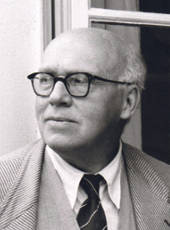

Walter Braunfels
*19 December 1882
†19 March 1954
Works by Walter Braunfels
Biography
Walter Braunfels was born on 19 December 1882 in Frankfurt am Main. He was the youngest child of the lawyer and writer Louis (Lazarus) Braunfels (1810–1883) and his second wife, Helene, née Spohr, his junior by 32 years.
After completing school education and musical training at the Dr. Hoch Conservatory – into which he was accepted as early as 1895 – he began in 1901 to study economics in Munich and Kiel. Deciding however to dedicate himself to music, he moved to Vienna for a year in 1902 to perfect his piano skills with Theodor Leschetitsky and to study music theory with Karl Nawratil.
From 1903 he lived in Munich where he studied composition with Ludwig Thuille. Here he met the conductor Felix Mottl who was to have the most profound formative influence on Braunfels’ development. From 1903 he worked as Mottl’s assistant at the National Theatre in Munich. From 1903 Braunfels also appeared regularly in public as a pianist. His first major success as a composer came in 1909 with the première of his Symphonic Variations op. 15 under Hermann Abendroth in Lübeck and his first opera, Prinzessin Brambilla, op 12 (after E. T. A. Hoffmann) under Max von Schillings in Stuttgart. In the same year he married Bertha von Hildebrand, the youngest daughter of the sculptor Adolf von Hildebrand.
World War I was a turning point in Braunfels’ life – and not just from a musical point of view. He was conscripted in 1915 and saw combat duty in France, where he was wounded. Traumatised by the experiences at the front and grateful to have survived the inferno, the protestant Braunfels converted to Catholicism.
His opera Die Vögel (The Birds), after Aristophanes, premièred in 1920 by Bruno Walter in Munich’s National Theatre, was a sensational success and proved to be his musical breakthrough. Other works such as Phantastische Erscheinungen eines Themas von Hector Berlioz (Fantastic Appearances of a Theme by Hector Berlioz), Te Deum, Don Gil von den Grünen Hosen (Don Gil of the Green Trousers), the Grosse Messe (Grand Mass) and Don Juan were performed by renowned conductors such as Wilhelm Furtwängler, Otto Klemperer and Max von Schillings and became part of the repertoire of almost all German theatres and concert halls. They also achieved great international acclaim.
In 1923 Braunfels became a member of the Berlin Academy of the Arts and in 1925, together with Abendroth, he was appointed as founding director of the Cologne Academy of Music. With the Nazis’ rise to power in 1933 Braunfels was listed as half-Jewish and all his works were banned. As a persona non grata he was required to withdraw from all public offices. The Reichsmusikkammer expressly prohibited him from undertaking any musical activities. As he did not feel able to emigrate, he moved with his family to Lake Constance near the border to Switzerland.
Among the works he wrote during his inner emigration between 1933 and 1945 are three operas: Die Verkündung (The Annunciation by Paul Claudel), Der Traum ein Leben (The Dream, a Life, after Grillparzer) and Jeanne d’Arc – Szenen aus dem Leben der heiligen Johanna (Scenes from the Life of Saint Joan, based on documents from her trial), four cantatas, three string quartets and a quintet. In 1945, after the end of the war, Konrad Adenauer reinstated Walter Braunfels as director of the Cologne Academy of Music. During the years of reconstruction and after his retirement in 1950 he wrote numerous works including the Sinfonia Concertante op. 68, Sinfonia brevis op. 69, Hebridentänze (Dances of the Hebrides) op. 70 and Passionsspiel (Passion Play) op. 72.
Braunfels died on 19 March 1954 in Cologne.
After 1945 his works were scarcely able to compete against the more favoured serial music. His compositions, which display a stylistic individuality between late romanticism and classical modernism, have since the 1990s once more been performed with increasing frequency and international success.
Susanne Bruse
About the music
Walter Braunfels described his opera The Birds as “a lyrical, fantastical game”. Based on Aristophanes, the opera became a triumph after its Munich premiere in 1920. For Bruno Walter it was “one of the most interesting new works” of his time in Munich, and the critic Alfred Einstein, who compared the opera with Wagner’s Meistersinger [The Mastersingers] and Pfitzner’s Palestrina, saw it as “a work of yearning for the pure realm of fantasy, art, poetry, and at once a fulfilment of this yearning, a leap into a world beyond time and bias”.
Braunfels began his opera in 1913. He completed it after the shocking experiences of the First World War, which changed his perspective on the world. Now he was driven by the search for timeless alternative worlds. He found the moments of salvation he sought in art, and in his Catholic faith, which was as fundamental to Braunfels as it was to Anton Bruckner or Olivier Messiaen. This can already be seen in The Birds – Braunfels added Christian elements to the classical pagan source material. His faith in a divine order to the world also shaped his Te Deum (1922), a glowing confessional work with a symphonic structure, whose monumental effect is comparable to Gustav Mahler’s Sinfonie der Tausend [Symphony of a Thousand].
Walter Braunfels was born in 1882 in Frankfurt am Main, the son of a Jewish father and a Christian mother. He trained as a pianist under James Kwast and Theodor Leschetitzky. He chose Ludwig Thuille, the head of the neoromantic Munich school, as his composition teacher. But an even more important figure was conductor Felix Mottl, who he was permitted to assist, and to whom he owed his enduring knowledge of Bruckner and, most importantly, Berlioz. Other strong influences included the circle of poets around Stefan George, the sculptor Adolf von Hildebrand and the archaeologist Adolf Furtwängler. These influences may have encouraged his tendency to look to the past, along with his delight in masks and disguises – as can be seen as much in the stage works Princess Brambilla (1909) and Don Gil of the Green Trousers (1924) as in the orchestral transfigurations of Phantastische Erscheinungen eines Themas von Hector Berlioz (1917) or Don Juan (1924).
But this playful approach to shifting identities and lyrical-fantastical visions also presented problems for Braunfels. During the First World War he complained that “too many different kinds of blood” were mixed within him which “pulled [him] in different directions”. “For such unevenly created natures as mine, the only thing that helps is to focus the will completely on a single point – and that is only possible in a monastery”. He thought of his conversion to Catholicism as a similarly clear decision – both an ethical and an aesthetic safeguard.
In 1933, Walter Braunfels lost his position as director of the Cologne Conservatory and his membership of the Prussian Academy of Arts for racial and political reasons. As his works could no longer be performed, he withdrew into “internal emigration”. He found solace, even more strongly than before, in his Christian faith. In the mystery play Annunciation (1933–1935) based on Paul Claudel, the composer’s own situation is reflected in the main characters, lepers rejected from society, and in the corresponding musical style, which is more bitter, and more linear. Another outsider was Joan of Arc, to whom he dedicated his 1943 Jeanne d’Arc – Scenes from the Life of Saint Joan. Tellingly, both these two key works are based on French, not German, source material.
“Mottl’s educational impact can be seen in his sense of style, his assured recognition of what is artistically valuable and his rejection of the sensational, in the way he connects soft naturalism and healthy objectivity, and in his distance from any kind of affectation”. Braunfels paid tribute to his role model Felix Mottl in this sentence, but he could equally have been talking about himself.
He was a conservative, like Hans Pfitzner and Wilhelm Furtwängler. When his music seems natural and unforced – “timeless and out of time” – this lack of external effects is deliberate. His music combines the movement structure of Beethoven or Brahms with the orchestral colours of Berlioz, Wagner and Strauss. Even the operas are more often symphonic than dramatic in structure.
For Braunfels, the beauty of the triad was the basis of all music. He only pushed occasionally at the boundaries of tonality, as for example in his characterisation of the lepers of Annunciation or the conflicted opposing figures of St Joan. The dissonances which open his 14 Preludes, for example, soon resolve into consonance. A sound world related to that of Brahms and Reger proves itself to be the composer’s natural habitat. In setting religious visions and miracles that can only be explained by faith, he employed fantastical aural effects, often chorally heightened. Other memorable details include the cries of individual words in Te Deum or the high bell tones at the end of Annunciation, which begin quietly and then grow to drown out the chords around them, and end up hammered out, almost fanatically.
The music of Walter Braunfels once touched audiences and musicians alike. Although great conductors like Busch, Furtwängler, Knappertsbusch, Klemperer and Walter championed his work, it fell into obscurity after 1945, because it did not fit contemporary ideas of progress. Only the opening up of aesthetic sensibilities since the 1970s has given it a chance again. The rediscovery of Braunfels began with The Birds, which had once been his breakthrough success. A significant work like Saint Joan did not see a staged performance until 2008 at the Deutsche Oper in Berlin. We can expect further new discoveries.
Albrecht Dümling
